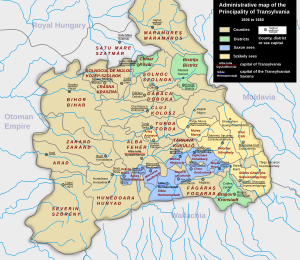트란실바니아 후국
(트란실바니아 공국에서 넘어옴)
| 트란실바니아 후국 | ||||
|---|---|---|---|---|
| Principatus Transsilvaniae | ||||
| ||||
 1570년 당시 트란실바니아 후국 | ||||
 17세기 중반 후국의 행정 구역 | ||||
| 수도 | 알바이울리아 시비우 | |||
| 인문 | ||||
| 공용어 | 라틴어 독일어 헝가리어 루테니아어 | |||
| 종교 | ||||
| 종교 | 개신교 가톨릭 동방 정교회 유대교 이슬람교 | |||
| 기타 | ||||
| 현재 국가 | ||||
| 이슬람교는 오스만 제국의 점령 이후 들어왔다. | ||||
트란실바니아 후국(독일어: Fürstentum Siebenbürgen; Erdélyi Fejedelemség; 라틴어: Principatus Transsilvaniae; 루마니아어: Principatul Transilvaniei or Principatul Ardealului)은 반독립국으로 헝가리인 대공이 주로 통치했던 국가였다.[1][2][3][4][5][6] 트란실바니아의 영토는 헝가리 동부 지역을 포함했고 파티움이라 불리었다. 후국은 1570년 슈파이어 조약의 체결과 깊은 연관이 있다.[7][8] 그러나 스테판 바토리가 폴란드의 왕이라는 지위를 갖고 있었기 때문에 트란실바니아가 후국이라는 명칭 하에 건국될 수 있었다.[9] 16세기부터 17세기까지 오스만 제국의 지배를 받기 시작한 이후 트란실바니아 후국은 합스부르크 헝가리와 오스만 제국 양쪽의 복속국이 되었다.[10][11]
후국은 헝가리 왕국의 영토로 남아 있었으며[12] 헝가리의 자주적인 지위라는 것을 상징했다.[13] 트란실바니아는 합스부르크 가문이 다스리는 헝가리의 잠식에 맞서 헝가리의 이익을 대표하기도 했다.[14] 전통적인 헝가리 법이 후국 내에서 유지되고 있었고,[10] 후국은 개신교가 수적으로 우세했다.[15]
각주[편집]
- ↑ Helmut David Baer (2006). 《The struggle of Hungarian Lutherans under communism》. Texas A&M University Press. 36–쪽. ISBN 978-1-58544-480-9. 2011년 7월 14일에 확인함.
- ↑ Eric Roman (2003). 《Austria-Hungary & the successor states: a reference guide from the Renaissance to the present》. Infobase Publishing. 574–쪽. ISBN 978-0-8160-4537-2. 2011년 7월 14일에 확인함.
- ↑ J. Atticus Ryan; Christopher A. Mullen (1998). 《Unrepresented Nations and Peoples Organization: yearbook》. Martinus Nijhoff Publishers. 85–쪽. ISBN 978-90-411-1022-0. 2011년 7월 14일에 확인함.
- ↑ Iván Boldizsár (1987). 《NHQ; the new Hungarian quarterly》. Lapkiadó Pub. House. 41쪽. 2011년 7월 14일에 확인함.
- ↑ Marshall Cavendish (2009). 〈Greece and the Eastern Balkans〉. 《World and Its Peoples: Europe》 11. Marshall Cavendish. 1476쪽. ISBN 978-0-7614-7902-4. 2011년 7월 14일에 확인함.
- ↑ Paul Lendvai (2003). 《The Hungarians: a thousand years of victory in defeat》. C. Hurst. 106–쪽. ISBN 978-1-85065-673-9. 2011년 7월 14일에 확인함.
- ↑ Richard C. Frucht, Eastern Europe: An Introduction to the People, Lands, and Culture, Volume 1, ABC-CLIO, 2004, p. 408
- ↑ Diarmaid MacCulloch, The Reformation, Viking, 2004, p. 443
- ↑ Katalin Péter, Beloved Children: History of Aristocratic Childhood in Hungary in the Early Modern Age, Central European University Press, 2001, p. 27
- ↑ 가 나 Dennis P. Hupchick, Conflict and chaos in Eastern Europe, Palgrave Macmillan, 1995, p. 62
- ↑ Peter F. Sugar, Southeastern Europe under Ottoman rule, 1354–1804, University of Washington Press, 1993, pp. 150–154
- ↑ Martyn Rady, Customary Law in Hungary: Courts, Texts, and the Tripartitum, Oxford University Press, 2015, p. 141, ISBN 9780198743910
- ↑ Károly Kocsis, Eszter Kocsisné Hodosi, Ethnic Geography of the Hungarian Minorities in the Carpathian Basin[깨진 링크(과거 내용 찾기)], Simon Publications LLC, 1998, p. 106
- ↑ Transylvania article of Encyclopædia Britannica
- ↑ István Lázár, Hungary, a Brief History, 1989, ISBN 963-13-4483-5


